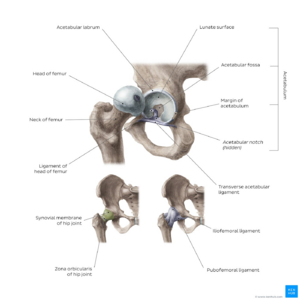McCarthy test: Difference between revisions
Hunter Logan (talk | contribs) (added a definition of the test, relevant anatomy, and proper techniques) |
Hunter Logan (talk | contribs) mNo edit summary |
||
| Line 16: | Line 16: | ||
== Clinically Relevant Anatomy == | == Clinically Relevant Anatomy == | ||
[[File:Hip joint - Kenhub.png|thumb|Hip Joint Anatomy<ref>''Hip joint - Kenhub.png''. (n.d.). Physiopedia. Retrieved April 5, 2022, from <nowiki>https://www.physio-pedia.com/File:Hip_joint_-_Kenhub.png</nowiki> | [[File:Hip joint - Kenhub.png|thumb|Hip Joint Anatomy<ref>''Hip joint - Kenhub.png''. (n.d.). Physiopedia. Retrieved April 5, 2022, from <nowiki>https://www.physio-pedia.com/File:Hip_joint_-_Kenhub.png</nowiki> | ||
</ref>]] | </ref>]] | ||
The acetabulofemoral (hip) joint is the largest and most stable joint in the human body. The joint is surrounded by ligaments that work to keep this articulation intact. Movements of this joint are facilitated by the proximal head of the femur articulating in the acetabulum of the pelvic girdle. The acetabular labrum is a soft-tissue structure which lines the acetabular rim of the hip joint.<ref name=":0">Bsat, S., Frei, H., & Beaulé, P. E. (2016). The acetabular labrum: a review of its function. ''The Bone & Joint Journal'', ''98-B''(6), 730–735. <nowiki>https://doi.org/10.1302/0301-620X.98B6.37099</nowiki> | The acetabulofemoral (hip) joint is the largest and most stable joint in the human body. The joint is surrounded by ligaments that work to keep this articulation intact. Movements of this joint are facilitated by the proximal head of the femur articulating in the acetabulum of the pelvic girdle. The acetabular labrum is a soft-tissue structure which lines the acetabular rim of the hip joint.<ref name=":0">Bsat, S., Frei, H., & Beaulé, P. E. (2016). The acetabular labrum: a review of its function. ''The Bone & Joint Journal'', ''98-B''(6), 730–735. <nowiki>https://doi.org/10.1302/0301-620X.98B6.37099</nowiki> | ||
| Line 22: | Line 21: | ||
</ref>In normal hip joint biomechanics, the labrum is crucial in retaining a layer of pressurized intra-articular fluid for joint lubrication and load support/distribution.<ref name=":0" /> Its seal around the femoral head is further regarded as a contributing to hip stability through its suction effect.<ref name=":0" /> | </ref>In normal hip joint biomechanics, the labrum is crucial in retaining a layer of pressurized intra-articular fluid for joint lubrication and load support/distribution.<ref name=":0" /> Its seal around the femoral head is further regarded as a contributing to hip stability through its suction effect.<ref name=":0" /> | ||
[[ | [[Functional Anatomy of the Hip-Bones and Ligaments?utm source=physiopedia&utm medium=search&utm campaign=ongoing internal |Click here]] for more detailed information on the anatomy on the hip joint. | ||
== Technique == | == Technique == | ||
| Line 31: | Line 30: | ||
'''Step 3:''' The clinician should then externally rotate the hip as the leg is moved back into extension. | '''Step 3:''' The clinician should then externally rotate the hip as the leg is moved back into extension. | ||
'''Step 4:''' Repeat steps 1 and 2 but | '''Step 4:''' Repeat steps 1 and 2 but internally rotate the hip as the leg is moved back into extension. | ||
Painful popping or clicking while performing the test indicates a possible hip labrum tear. | |||
== References == | |||
[[Category:Special_Tests]] | [[Category:Special_Tests]] | ||
<references /> | <references /> | ||
Revision as of 21:14, 5 April 2022
Original Editors - Add your name/s here if you are the original editor/s of this page. User Name
Top Contributors - Hunter Logan, Kim Jackson, Aminat Abolade, Baile Louderback, Robert Storrow, Olajumoke Ogunleye, Kenny Bosmans, George Prudden, Wanda van Niekerk and Cindy John-Chu
For the McCarthy test, both hips have to be in a flexed position. The affected hip needs to be brought into extension. If this movement reproduces a painful click, the patient is suffering from a labral tear.
[1]
Definition[edit | edit source]
The McCarthy Test is a clinical test used to aid in the diagnosis of a hip labral tear.
Clinically Relevant Anatomy[edit | edit source]

The acetabulofemoral (hip) joint is the largest and most stable joint in the human body. The joint is surrounded by ligaments that work to keep this articulation intact. Movements of this joint are facilitated by the proximal head of the femur articulating in the acetabulum of the pelvic girdle. The acetabular labrum is a soft-tissue structure which lines the acetabular rim of the hip joint.[3]In normal hip joint biomechanics, the labrum is crucial in retaining a layer of pressurized intra-articular fluid for joint lubrication and load support/distribution.[3] Its seal around the femoral head is further regarded as a contributing to hip stability through its suction effect.[3]
Click here for more detailed information on the anatomy on the hip joint.
Technique[edit | edit source]
Step 1: The patient should be laying supine with their head supported and with both arms rested to their side in a comfortable position.
Step 2: The examiner should then passively flex the affected hip to end range.
Step 3: The clinician should then externally rotate the hip as the leg is moved back into extension.
Step 4: Repeat steps 1 and 2 but internally rotate the hip as the leg is moved back into extension.
Painful popping or clicking while performing the test indicates a possible hip labrum tear.
References[edit | edit source]
- ↑ McCarthy JC, Noble P, Schuck M, Alusio FV, Wright J, Lee J. “Acetabular and labral pathology.” In: McCarthy JC, editor. Early hip disorders. New York7 Springer Verlag; 2003. p. 113-33.
- ↑ Hip joint - Kenhub.png. (n.d.). Physiopedia. Retrieved April 5, 2022, from https://www.physio-pedia.com/File:Hip_joint_-_Kenhub.png
- ↑ 3.0 3.1 3.2 Bsat, S., Frei, H., & Beaulé, P. E. (2016). The acetabular labrum: a review of its function. The Bone & Joint Journal, 98-B(6), 730–735. https://doi.org/10.1302/0301-620X.98B6.37099






